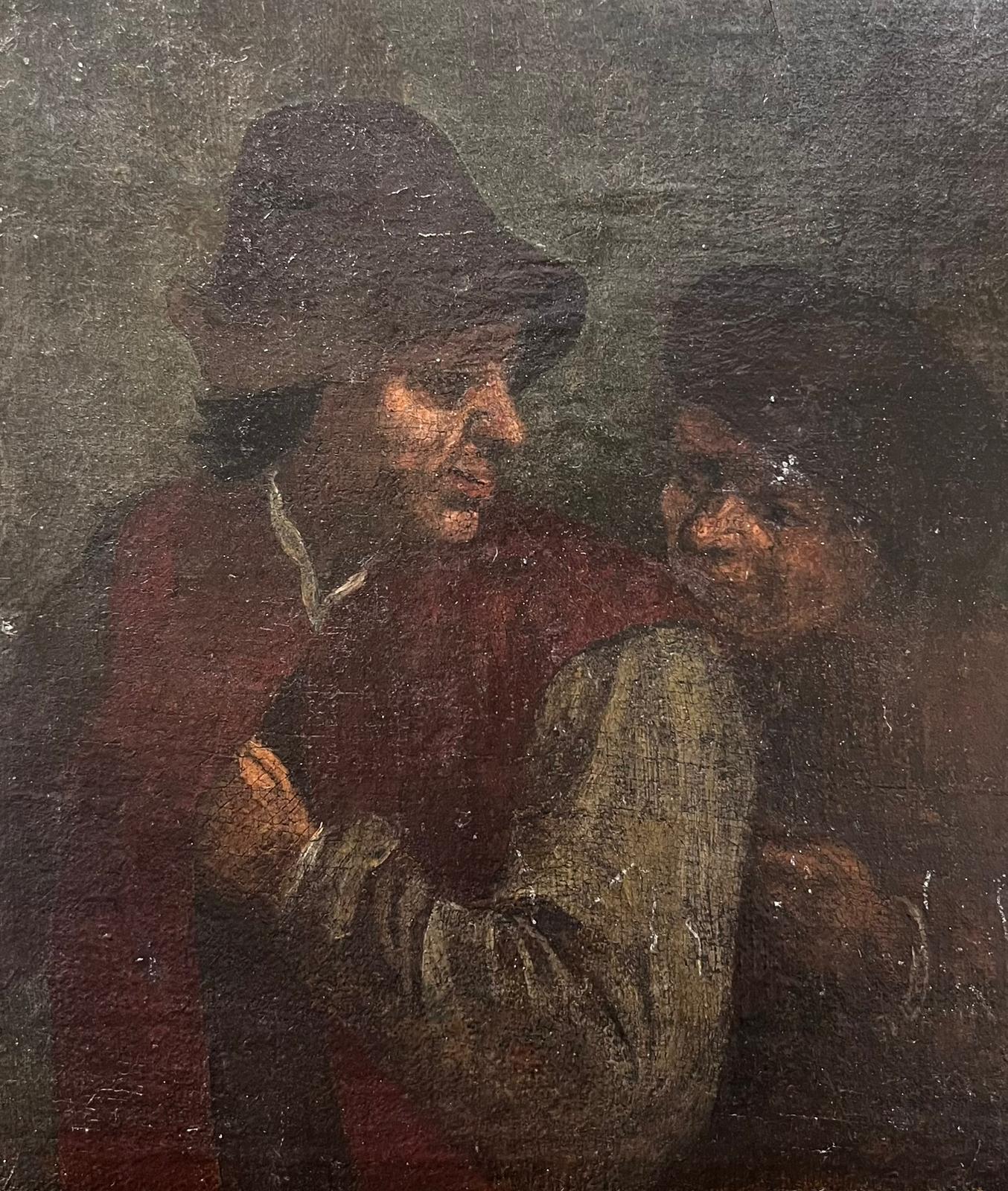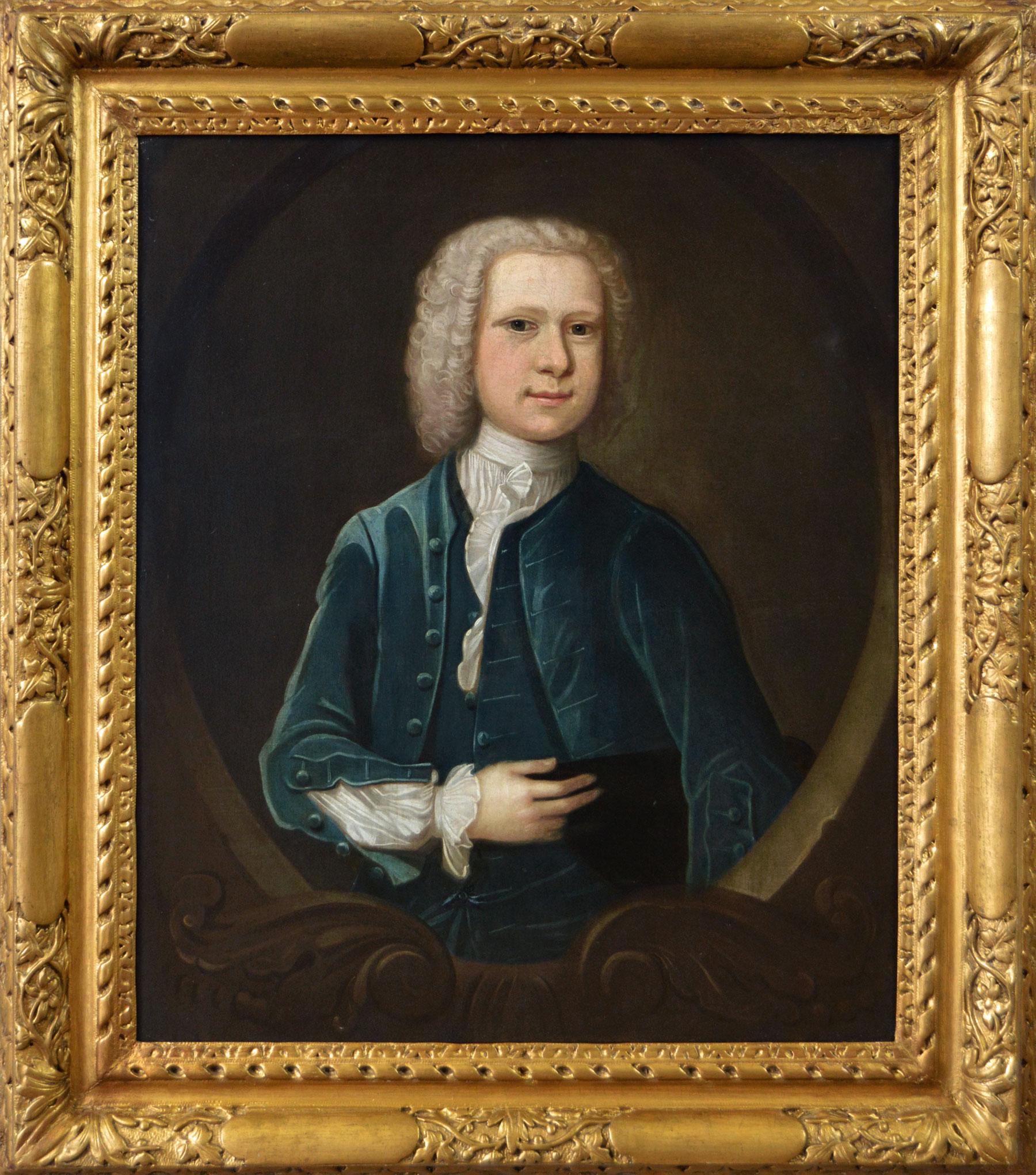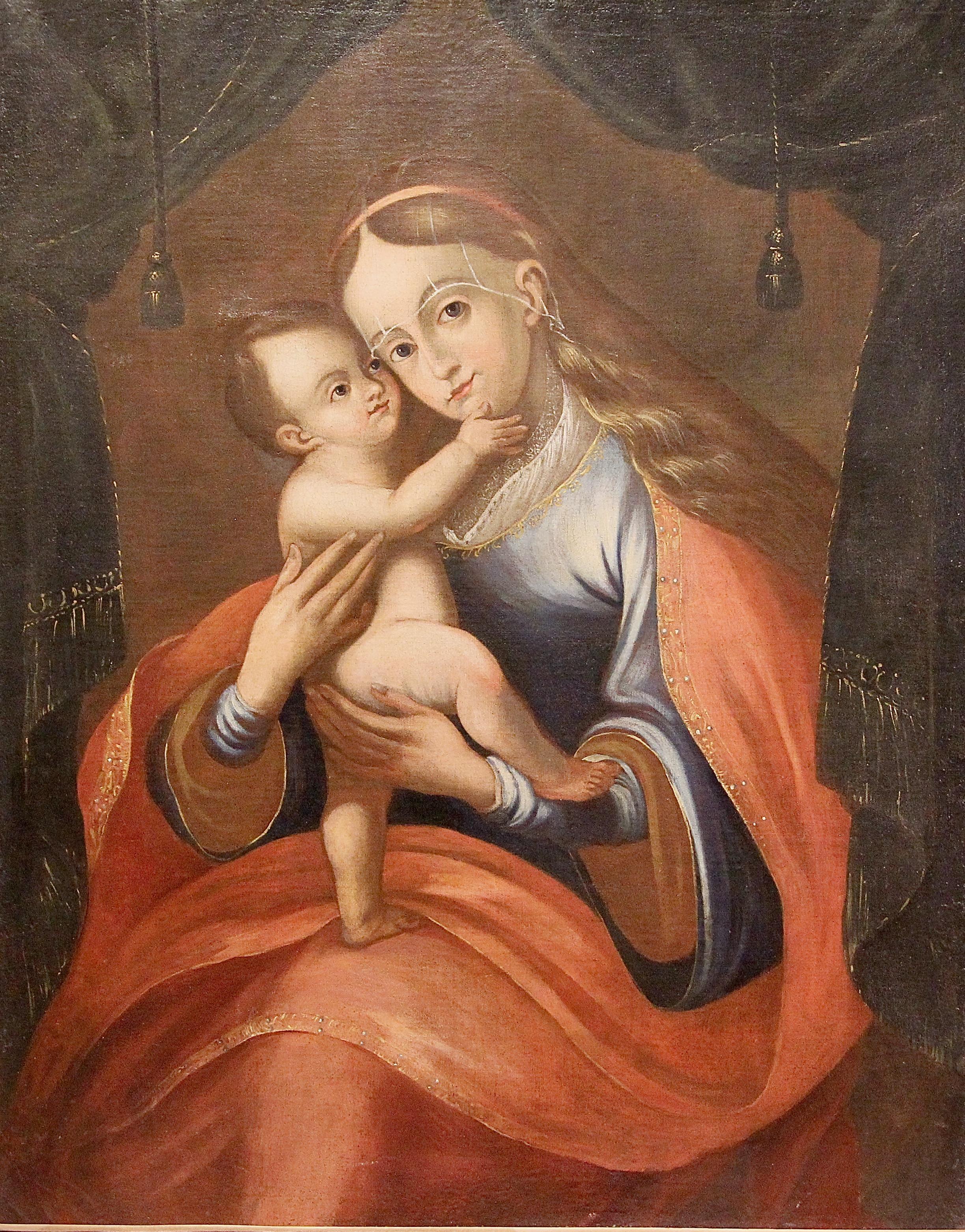Items Similar to 17th Century portrait oil painting of a gentleman
Want more images or videos?
Request additional images or videos from the seller
1 of 12
17th Century portrait oil painting of a gentlemanC1680
C1680
About the Item
Circle of Willem Wissing
Dutch, (1656-1687)
Portrait of a Gentleman
Oil on canvas
Image size: 29 inches x 24.5 inches
Size including frame: 35 inches x 30.5 inches
A well-executed half-length portrait of a gentleman, circle of Willem Wissing set in a feigned sculptured oval cartouche. The subject posed in a full, dark wig wears a brown robe over a gold brocade jacket and lace cravat. His wig, fashionable dress and confident expression all indicate this is a gentleman of some standing in society, possibly nobility. The painting has clearly been executed by an artist of great ability who has been influenced by Willem Wissing. The identity of the subject painted here has been lost over time as is often the case with portraits of this date.
Willem or William Wissing was born in Amsterdam in 1656. He studied at The Hague under Willem Doudijns (1630–97) and Arnoldus van Ravestyn (1615–90) before moving to England in 1676. There he studied under Sir Peter Lely and also served as his assistant at his studio. After the death of Lely Wissing set up his own successful studio and won commissions to paint the portraits of many prominent sitters and was assisted by fellow Dutch immigrant Jan van der Vaart. He died in Lincolnshire in 1687. Examples of his paintings are held by the Cromwell Museum, English Heritage, Ferens Art Gallery, Holburne Museum, National Galleries of Scotland, National Portrait Gallery, National Trust, Victoria Art Gallery and the Yale Centre for British Art.
Presentation: The painting is housed in a new, English made ebonised frame with gilt slip which is in excellent condition.
Condition: As with all of our original antique oil paintings, this work is offered in ready to hang gallery condition, having been professionally cleaned, restored and revarnished.
© Benton Fine Art
- Creation Year:C1680
- Dimensions:Height: 35 in (88.9 cm)Width: 30.5 in (77.47 cm)Depth: 2.5 in (6.35 cm)
- Medium:
- Movement & Style:
- Circle Of:Willem Wissing (1656 - 1687, Dutch)
- Period:
- Condition:
- Gallery Location:Moreton-In-Marsh, GB
- Reference Number:1stDibs: LU15627657472
About the Seller
4.9
Platinum Seller
These expertly vetted sellers are 1stDibs' most experienced sellers and are rated highest by our customers.
Established in 1972
1stDibs seller since 2015
271 sales on 1stDibs
Typical response time: <1 hour
Associations
The British Antique Dealers' AssociationLAPADA - The Association of Arts & Antiques DealersInternational Confederation of Art and Antique Dealers' Associations
- ShippingRetrieving quote...Ships From: Moreton-In-Marsh, United Kingdom
- Return PolicyA return for this item may be initiated within 3 days of delivery.
More From This SellerView All
- 18th Century portrait oil painting of a gentlemanLocated in Moreton-In-Marsh, GloucestershireFollower of Enoch Seeman the Younger German, (1694-1744) Portrait of Gilbert Sympkin Oil on canvas Image size: 29.25 inches x 24.5 inches Size including frame: 38 inches x 33.25 inches A fine three quarter length portrait of a gentleman traditionally identified as Gilbert Simpkin (Sympkin), follower of Enoch Seeman the younger, C1720. The portrait is set in a feigned sculptured oval cartouche, a device used to give a sense of depth. The sitter is depicted wearing a fashionable blue jacket and matching waistcoat with a white chemise and lace jabot. He wears a powdered wig in the fashionable style of the day and is posed holding his hat under his left arm with the fingers of his right hand stretched out. At court, long fingers signified wealth, culture and intelligence. The painting has clearly been executed by an artist of great ability who has been influenced by Enoch Seeman the younger. Gilbert Simpkin (Sympkin) was born in London on 24 August 1683, the son of John Simpkin and Susannah Butler. His grandfather was also called Gilbert Simpkin. He entered Oxford University in 1700 where he studied at St John’s College. In 1702, he became a student of Middle Temple, which at the time was one of the world’s most important centres of legal education. He later settled in Plymouth and then Bristol. He died in Bristol on 15 May, 1744 and was buried at Bristol Cathedral. He remained unmarried and the portrait may well have been commissioned to commemorate when he was first Called to the Bar or perhaps had established his own practice. Enoch Seeman or Seemann the younger was born in Danzig, Germany now Gdansk, Poland in 1694. His father was Enoch Seeman Senior, an artist of Flemish origin and his brothers Isaac, Noah and Abraham also became artists. He came to London with his father and brothers around 1704 and established himself as a portrait artist. From 1717 he became painter to the Royal court painting...Category
18th Century Old Masters Portrait Paintings
MaterialsCanvas, Oil
- 18th Century portrait oil painting of a girl with an orangeBy Robert ByngLocated in Moreton-In-Marsh, GloucestershireCircle of Robert Byng British, (1666-1720) Girl with Orange Oil on canvas Image size: 29 inches x 24 inches Size including frame: 36 inches x 31 inc...Category
18th Century Old Masters Portrait Paintings
MaterialsCanvas, Oil
- 17th Century portrait oil painting of a LadyBy Michael DahlLocated in Moreton-In-Marsh, GloucestershireCircle of Michael Dahl Swedish, (1659-1743) Portrait of a Lady Oil on canvas Image size: 29 inches x 24 inches Size including frame: 36 inches x 31 inches A fine half-length portra...Category
17th Century Old Masters Portrait Paintings
MaterialsCanvas, Oil
- 17th Century portrait oil painting of a ladyBy Studio of Sir Peter LelyLocated in Moreton-In-Marsh, GloucestershireStudio of Sir Peter Lely Dutch, (1618-1680) Portrait of a Lady Oil on canvas Image size: 29.25 inches x 24.25 inches Size including frame: 37...Category
17th Century Old Masters Portrait Paintings
MaterialsCanvas, Oil
- 17th Century portrait oil painting of a gentlemanBy John RileyLocated in Moreton-In-Marsh, GloucestershireCircle of John Riley British, (1646-1691) Portrait of a Gentleman Oil on canvas Image size: 29 inches x 24 inches Size including frame: 36 inches x 31 inch...Category
17th Century Old Masters Portrait Paintings
MaterialsCanvas, Oil
- 17th Century portrait oil painting of a ladyLocated in Moreton-In-Marsh, GloucestershireCircle of Sir Peter Lely Dutch, (1618-1680) Portrait of a Lady, traditionally identified as Princess Henrietta Anne Stuart Oil on canvas Image...Category
17th Century Old Masters Portrait Paintings
MaterialsOil, Canvas
You May Also Like
- 17th Century by Giovanni Battista Beinaschi Saint Bartholomew Oil on CanvasBy Giovanni Battista BeinaschiLocated in Milano, LombardiaGiovan Battista Beinaschi (Fossano, 1636 - Naples 1688) Saint Bartholomew Oil on canvas, cm. 96 x 71,5 – with frame cm. 108 x 86 Shaped and gilded ...Category
Mid-17th Century Old Masters Portrait Paintings
MaterialsCanvas, Oil
- 17th Century by Juan Alfonso Abril Head of St Paul Painting Oil on CanvasLocated in Milano, LombardiaJuan Alfonso Abril (active in the 17th century in Valladolid) Head of Saint Paul Oil on canvas, cm. 48,5 x 62 - with frame cm. 63 x 76,5 Shaped wooden f...Category
Early 17th Century Old Masters Figurative Paintings
MaterialsCanvas, Oil
- Portrait of a Lady in Blue Silk Dress & Crimson Mantle c.1695; by Thomas MurrayLocated in London, GBThe sitter is elegantly attired in a blue silk dress over a white frilled chemise and a striking crimson mantle. The artist, Thomas Murray, can be described as one of the most successful and talented during the last part of the seventeenth century. It is not surprising that Murray painted the portraits of King William III, Queen Mary, Queen Ann as well as several other high-ranking individuals. The influence of Sir Godfrey Kneller is evident and even expected considering the importance of Kneller, and even though the formula employed for head and shoulders portraits of woman during the period is similar, Murray’s work is distinguishable by a refined and elegant manner, a smooth overall feel, and often, distinctive eyes. Murray is known to have employed not only the same pattern as our portrait but the three distinctive colours (blue, white, red) many times. Thomas Murray was born in Scotland but moved to London to study with a member of the De Critz family. Later he was a pupil of the English portraitist John Riley (1646-1691), who was court painter to King William III and Queen Mary, and was practising as a painter on his own in the 1680s. In 1691 he took over Riley’s studio when that artist died in 1691 and he established a very successful practice. The Rev, James Dalloway accounted that Murray “was remarkable for his personal beauty and for the elegance of his manner” and he was also noted to have been hard working, courteous and popular with his customers. His portraiture retains an individual style and easily recognised but his earlier work is similar to John Closterman, who was a fellow pupil, and many consider this period to be his finest. Murray invested wisely in property and when he died in 1735, he left around £40,000. He had no children and he bequeathed his money to a nephew with instructions that his monument, with a bust, should be erected in Westminster Abbey, provided that it did not cost too much – but his nephew decided that it was indeed “too expensive” and the plan did not proceed. He is buried in St. Paul's, Covent Garden. Murray’s work is represented in many British country houses and private collections, the National Portrait Gallery London, Royal Society and Middle Temple in London, and in the Uffizi Gallery in Florence. A good example of 17th century British portraiture...Category
17th Century Old Masters Portrait Paintings
MaterialsCanvas, Oil
- Early 18th century portrait painting of Henrietta Paulet, Duchess of BoltonBy Maria VerelstLocated in Bath, SomersetPortrait of Henrietta Paulet, Duchess of Bolton, née Crofts, (c. 1682–1730), three-quarter length, standing on a colonnaded terrace wearing an ivory silk gown and holding a sprig of ...Category
Early 18th Century Old Masters Portrait Paintings
MaterialsCanvas, Oil
- A portrait of a lady and her daughter with an exotic birdBy Michael DahlLocated in Bath, SomersetA portrait of a lady three-quarter length, seated in an interior, wearing a red silk gown draped in a pink silk sash with an exotic bird perched on her hand and one arm resting on a stone plinth, her young daughter wearing a green silk gown standing at her side. Oil on canvas, housed in a period 'Lely' giltwood frame. This double portrait was painted at the height of Dahl's career in circa 1715 when Dahl had become firmly established as one of the leading portrait painters in Britain. Although the identities of the sitters are currently unknown, it is a sensitive depiction of a close and affectionate bond between a mother and daughter, with the young girl's hand resting affectionately on her mothers lap. The tamed exotic bird adds a charming decorative element which also serves to convey the high social status of the lady, given only the very wealthy would be able to own such a rare and expensive pet and the lively colouring of the bird's feathers is reflected in the colours of the sitters' silk gowns. Provenance: Private collection, London Michael Dahl (Stockholm 1659-1743 London) was born in Stockholm in Sweden and studied under Martin Hannibal (d 1741) and later with David Klöcker Ehrenstrahl. In 1682 he travelled to London, where he became acquainted with Godfrey Kneller and Henry Tilson, and in 1685 he left for Europe with Tilson, working briefly in Paris before continuing to Venice and Rome, where they stayed for about two years. In Rome Dahl converted to Roman Catholicism and gravitated towards the circle of Christina, former Queen of Sweden, who sat for him (Grimsthorpe Castle, Lincs). He returned to England with Tilson via Frankfurt and arrived in London in 1689, staying in England for the remainder of his career. During Dahl's absence, Kneller had consolidated his supremacy in London as the most fashionable portrait painter, but Dahl rapidly became Kneller’s closest competitor. His patrons probably had roots in the Swedish diplomatic circles, but it expanded as a result of his ability and his agreeable personality. His prices were lower than those of Kneller and he favoured softer, more diffused, colour tones and could respond to his sitters with sincerity and humanity. Politically, Kneller supported the ascendant Whigs while Dahl was a Tory, but they frequently painted the same sitters from both parties, and in spite of fundamental differences in technique and temperament, their work was sometimes similar in appearance. Dahl was prolific but rarely signed his work, and comparatively few of his portraits were engraved in mezzotint, the method used by Kneller to widen his reputation. By 1690 he had painted the aged Duke of Schomberg (engraved by William Faithorne) and Prince George of Denmark (London, Kensington Palace). He was ignored by William III but received commissions from Princess Anne, including one for a portrait of herself (Oakly Park, Ludlow, Salop). He also painted the future Duke and Duchess of Marlborough, and his informal portrait of the Duchess (Althorp House, Northants), formerly attributed to Kneller, is perhaps the most intimate of all images of her. During the 1690s he secured the patronage of Charles Seymour, the ‘Proud’ 6th Duke of Somerset, who ordered a series of seven full-length portraits of notable contemporary beauties from Dahl (1690s; Petworth House, W. Sussex, NT). This was originally a scheme similar to Kneller’s more famous ‘Hampton Court Beauties’, but the portraits were subsequently reduced to three-quarter-length formats. The features of the sitters are not individualized, but they possess a decorative, languorous glamour that recalls Lely rather than Kneller. Somerset gave Dahl further employment over the next 25 years. In 1698, following the death of Klöcker Ehrenstrahl, Dahl was offered the post of court painter at Stockholm, which he apparently refused, preferring to remain in London at his studio in Leicester Fields, near the Swedish legation. In about 1700 he was joined by a young compatriot, Hans Hysing, who worked with him for many years. Dahl seems not to have married until after 1708, He had a son Michael (d. 1741), also a painter, of whose work nothing is known, and two daughters. After the accession of Queen Anne in 1701, she and Prince George sat for a number of official portraits. His royal patronage ceased with Queen Anne’s death, and when Dahl refused to paint the infant Duke of Cumberland in 1722. He was suspected of Jacobite sympathies, and relations had cooled between him and the Swedish legation. However, his practice continued to prosper, and he acquired another important patron in Edward Harley, 2nd Earl of Oxford, who shared his political views and whose circle included the architect James Gibbs and the poets Matthew Prior and Alexander Pope, all of whom Dahl painted. Oxford commissioned several portraits of himself. In the earliest (1719; Welbeck Abbey...Category
Early 18th Century Old Masters Portrait Paintings
MaterialsCanvas, Oil
- English 18th century portrait of Henrietta Pelham-Holles, Duchess of Newcastle.By Charles JervasLocated in Bath, SomersetPortrait of Henrietta Pelham-Holles (née Godolphin) (1701-1776), Duchess of Newcastle, standing in a wooded landscape with a river beyond, three-quarter length wearing an ivory silk ...Category
1720s Old Masters Portrait Paintings
MaterialsOil, Canvas
Recently Viewed
View AllMore Ways To Browse
England Portrait
Dark Portrait
Antique Gentleman
Painting To Restore
Antique Dutch Oil Paintings Paintings
Antique Dutch Oil Painting Paintings
Gold Gilt Painting
Gilt Gold Painting
Painting Of A Gentleman
Cleaning Antique Oil Paintings
Dark House Painting
Antique Oval Painting
Gold Gilt Frame Paintings
Oval Framed Painting
Dutch Willem
Antique Gentleman Portrait
English Gentleman
Old English Oil Paintings





